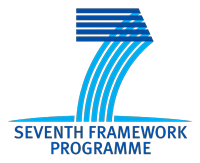Group Leader: Professor Barbara Pedley
Research
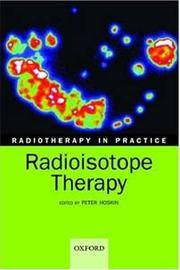
The group develops, tests and optimises selective cancer treatments in vitro and in vivo, using novel antibody and vascular targeted therapies as either single or combined strategies (Fig 1).
We have increasingly concentrated on the impact of the tumour microenvironment on therapy and vice versa, and a major part of our research concerns the development of systems for overcoming or exploiting tumour heterogeneity, in order to optimise future clinical trials. The most intensively studied tumour is colorectal carcinoma, but many of the other common tumours are also under investigation.
Fig 1. Dearling and Pedley 2007, Selective localisation of therapeutic radiolabeled antibody in colorectal liver metastases.
Tumour Heterogeneity
A detailed study of the tumour microenvironment has shown extensive regional heterogeneity in many parameters, including antigen expression, blood vessel distribution and perfusion, and hypoxia. These factors in turn influence the delivery and efficacy of therapeutic agents. We are using a wide range of biomarkers and digital, multiparametric imaging systems to define these characteristics in tumours and inform the rational design of therapy. Hypoxia is one of the major tumour parameters being investigated (Fig. 2), as this can increase radio- and chemo-resistance by approximately 3-fold compared to well oxygenated tumour regions.
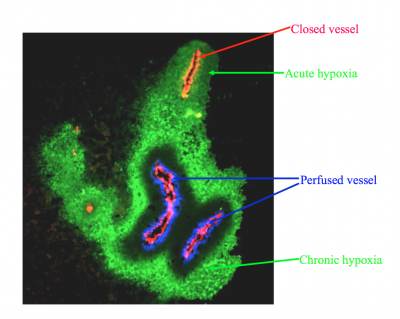
Fig 2.
Fluorescence microscopy image of tumour hypoxia in relation to blood vessels. This increases tumour resistance to therapy approximately 3-fold.
Therapeutic strategies against tumour cells
Much of our pre-clinical research involves the use of antibodies to selectively target therapeutic agents, such as radioactivity, to tumour cells while protecting normal tissues. Antibody distribution is quantified over time in relation to tumour biology, using radio- or fluorescently-labeled antibodies (Fig 3). Regional tumour damage and repair following therapy is also studied using further functional biomarkers, eg. TUNEL, caspase 3, H2AX, angiogenesis, apoptosis etc.
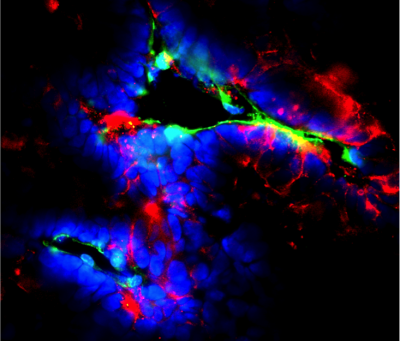
Fig 3.
Extravasation of a fluorescently labelled anti-CEA antibody(red) from a tumour blood vessel (green) at 5 minutes after intravenous injection. Tumour cell nuclei are shown in blue.
Therapeutic strategies against vasculature
We are employing a range of techniques to study tumour vasculature (Fig 4). This is highly abnormal compared with the vasculature of normal tissues, but it provides a useful target for therapy. There are several advantages to targeting the tumour vasculature instead of the tumour cells themselves. These include ease of access for the therapeutic, reduced likelihood of developing resistance, applicability to all solid tumours, and the fact that killing 1 capillary will destroy many more dependent tumour cells. We are approaching this in two ways: targeting the vasculature with therapeutic antibodies (Fig 5), or using vascular disrupting agents (VDAs). These agents rapidly reduce blood flow within the tumour, leading to destruction of existing blood vessels within the tumour and large areas of necrosis (Fig. 6).
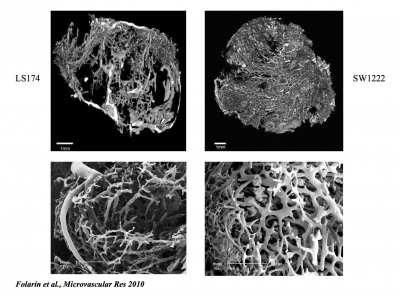
Fig 4.
3D analysis of tumour vascular corrosion casts for 2 colorectal tumours, using micro-computed tomography and stereo imaging
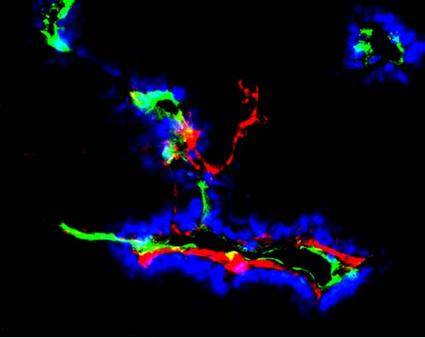
Fig 5.
Localisation of a fluorescently labeled anti-angiogenesis antibody (red) to tumour blood vessels (green). Surrounding tumour cells are shown in blue. The antibody targets a therapeutic agent to destroy both endothelial and tumour cells.
Combination therapies
Most cancer treatment will require a combination of different therapeutic agents in order to overcome the problem of heterogeneity and destroy the whole tumour. Using our advanced microscopy systems we have shown that VDAs destroy the majority of the tumour, but leave a viable outer rim which will continue to grow. However, this area is effectively targeted by antibody therapies (Fig 6), leading to a synergistic combined therapy which has entered clinical trial. Other novel, combined treatments using antibody-targeted and antivascular agents are constantly under investigation.
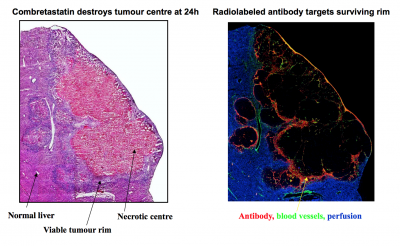
Fig 6.
Combination therapy: vascular disrupting agent (combretastatin) + antivascular antibody. Demonstration of how microscopy can determine the optimal combination of therapeutics for cancer treatment.
Selected Publications
Dearling JLJ, Qureshi U, Begent RHJ, Pedley RB. Combining radioimmunotherapy with anti-hypoxia therapy 2-deoxy-D-glucose results in reduction of therapeutic efficacy. Clin Cancer Res, 13:1903-1910, 2007.
El-Emir E, Qureshi U, Dearling JLJ, Boxer GM, Clatworthy I, Folarin AA, Robson MP, Konerding MA, Nagl S, Pedley RB. Predicting response to radioimmunotherapy from the tumor microenvironment of colorectal carcinomas. Cancer Res 67: 11896-11905, 2007 Pubmed
El Emir, E., Dearling, J.L, Huhalov, A., Robson, M., Boxer, Neri, D., I. A., van Dongen, GAMS, Begent, R.H..J. and Pedley, R.B. Characterisation and radioimmunotherapy of L19-SIP, an anti-angiogenic antibody against the extra domain B of fibronectin, in colorectal tumour models. Br J Cancer 96: 1862-1870, 2007. Pubmed
Fidarova EF, El-Emir E, Boxer GM, Qureshi U, Robson MP, Dearling JLJ, Trott KR, Begent RHJ, Pedley RB. Microdistribution of targeted, fluorescently-labeled anti-carcinoembryonic antigen antibody in metastatic colorectal cancer: implications for radioimmunotherapy. Clin Cancer Res 14:2639-2646, 2008 Pubmed
Violet JA, Dearling JLJ, Green AJ, Begent RHJ, Pedley RB. Fractionated 131I anti-CEA Radioimmunotherapy- Effects on xenograft tumour growth and haematological toxicity in mice. Br J Cancer 99: 632 – 638, 2008 Pubmed
Dearling JLJ, Flynn AA, Qureshi U, Whiting S, Boxer GM, Begent RHJB, Pedley RB. Localization of radiolabeled anti-CEA antibody in subcutaneous and intrahepatic colorectal xenografts: Influence of tumor size and location within host organ on antibody uptake. Nucl Med Biol 36: 883-894, 2009. Pubmed
Folarin AA, Konerding MA, Timonen J, Nagl S, Pedley RB. Three-dimensional analysis of tumour vascular corrosion casts using stereoimaging and micro-computed tomography. Microvascular Research 80:89-98, 2010.
Rajkumar V, Dearling JD, Packard A, Pedley RB. Radioimmunotherapy: optimizing delivery to solid tumors. Therapeutic Delivery 2 (5), 567-572. 2011.
Ran Yan, Ethaar El-Emir, Vineeth Rajkumar, Mathew Robson, Amit P. Jathoul, R. Barbara Pedley, and Erik Arstad. One-pot synthesis of an (125) I-labeled trifunctional reagent for multiscale imaging with optical and nuclear techniques. Angew. Chem. Int. Ed, 50, 6793 –6795, 2011
Jun Yang, Oliver Staples, Luke Thomas, Thomas Briston, Mathew Robson, Evon Poon, Maria Simoes, Ethaar El-Emir, Francesca Buffa, Afshan Ahmed, Nicholas Annear, Deepa Shukla, Barbara Pedley, Patrick H. Maxwell, Adrian Harris, Margaret Ashcroft. Human CHCHD4/MIA40 mitochondrial proteins regulate cellular oxygen consumption rate and metabolism, and provide a critical role in hypoxia signalling and tumour progression. J Clin Invest. 122(2):600-11, 2012.
Laufer J G, Johnson P, Zhang E Z, Treeby B, Cox B, Pedley R B and Beard P C In vivo preclinical photoacoustic imaging of tumor vasculature development and therapy. J Biomedical Optics 17(5) 056016, 2012.
Rajkumar VS, Boxer G, Robson M, Muddle J, Papastavrou Y, Pedley RB. A comparative study of PDGFR inhibition with imatinib on radiolabeled antibody targeting and clearance in two pathologically distinct models of colon adenocarcinoma. Tumor Biol. 33 (6) 2019 – 2029, 2012.
Walker-Samuel S, Ramasawmy R, Torrealdea F, Rega M, Johnson SP, Rajkumar V, Richardson S, Gonçalves M, Parkes HG, Thomas D, Pedley RB, Lythgoe MF, Golay X. In vivo imaging of glucose uptake and metabolism in tumors. Nat Med19 (8) 1067-1073, 2013.
Yan R, Sander K, Eva Galante E, Rajkumar V, Badar A, Robson M, El-Emir E, Lythgoe MF, Pedley RB, Arstad E. A One-Pot Three-Component Radiochemical Reaction for Rapid Assembly of 125I-labeled Molecular Probes. J. Am. Chem. Soc., 135: 703-709, 2013
Nikitenko LL, Shimosawa T, Henderson S, Mäkinen T, Shimosawa H, Qureshi U, Pedley RB, Rees M P, Fujita T, Boshoff C. Adrenomedullin Haploinsufficiency Predisposes to Secondary Lymphedema. J Invest Dermatol. 133, 1768–1776, 2013
Eletheria Panagiotaki, Simon Walker-Samuel, Bernard Siow, S. Peter Johnson, Vineeth Rajkumar, R. Barbara Pedley, Mark F. Lythgoe, Daniel C. Alexander. Non-invasive quantification of solid tumour microstructure with VERDICT MRI. Cancer Res 74(7):1902-1912, 2014.
Jathoul AP, Laufer J, Ogunlade O, Treeby B, Cox B, Zhang E, Johnson P, Pizzey AR, Philip B, Marafioti T, Lythgoe MF, Pedley RB, Pule M and Beard P. Deep in vivo photoacoustic imaging of mammalian tissues using a tyrosine-based genetic reported. Nature Photonics 9: 239-246, 2015.
Rajkumar V, Goh V, Siddique M, Robson M, Boxer G,Cook GJR, Pedley RB. Novel application of texture analysis to SPECT images of 125I-A5B7 anti-CEA antibody localisation in metastatic colorectal cancer models: Correlation with histological microarchitecture and response to antivascular therapy. Br J Cancer 112: 1882-1887, 2015.
Vassileva V, Rajkumar V, Mazzantini M, Robson M, Badar A, Sharma S, Årstad E, Hochhauser D, Lythgoe MF, Boxer GM, Pedley RB. Significant therapeutic efficacy with combined radioimmunotherapy and cetuximab in pre-clinical models of colorectal cancer. J Nucl Med, 2015, doi:10.2967/jnumed.115.157362.
Nunes JPM, Morais M, Vassileva V, Robinson E, Rajkumar V, Smith MEB, Pedley RB, Caddick S, Baker JR, Chudasama V. Next generation maleimides (NGMs) enable delivery of potent, site-selectively modified antibody-drug conjugates (ADCs). Chem Comm: DOI:10.1039/c5cc03557k, 2015.
Ohnmacht SA, Marchetti C, Gunaratnam M, Besser RJ, Haider SM,Di Vita G, Lowe HL, Mellinas-Gomez M, Diocou S, Robson M, Šponer J, Islam B, Pedley RB, Hartley JA & Neidle S. A G-quadruplex-binding compound showing anti-tumour activity in an in vivo model for pancreatic cancer. Scientific Reports: DOI: 10.1038/srep11385, 2015.
Goncalves M, Johnson S, Ramasawmy R, Pedley RB, Lythgoe M, Walker-Samuel S. Decomposition of spontaneous fluctuations in tumour oxygenation using BOLD MRI and independent component analysis. B J Cancer 113: 1168–1177, 2015
 Close
Close





